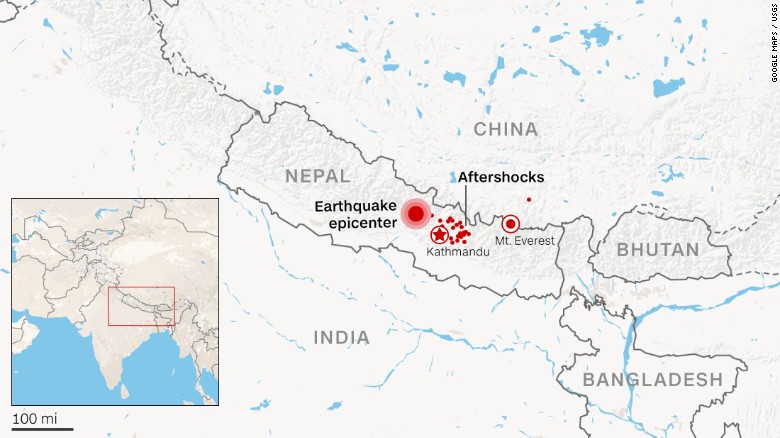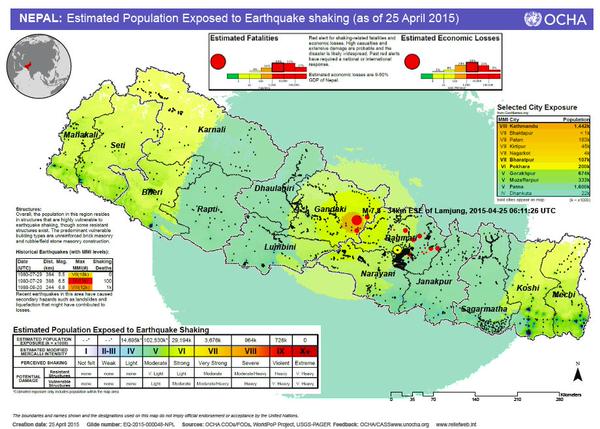Nepal tries to cope with devastation of earthquakes
By Manesh Shrestha, Ralph Ellis and Mark Morgenstein, CNN
Updated 1721 GMT (0021 HKT) April 26, 2015
The death toll in Nepal from Saturday’s catastrophic earthquake has jumped to at least 2,430, Nepal Home Affairs Ministry spokesman Laxmi Prasad Dhakal said Sunday. More than 4,000 other people were reported injured in Nepal, the spokesman said. India’s death toll has reached 56, most of them in Bihar state, said Lt. Gen. N.C. Marwah, a senior official of India’s National Disaster Management Authority. Also, 17 Chinese nationals died in Tibet, according to Chinese state-run news agency Xinhua. These figures bring the overall death toll to more than 2,500.
They dug through rubble, looking for survivors but usually finding bodies. At night, they slept in open fields in the frigid night air. Food and clean water became rarities.
Life has always been hard for people in Nepal, one of the world’s poorest nations, but on Sunday it became clear that day-to-day existence had turned into a struggle to survive. A series of earthquakes killed more than 2,000 people and left the nation in shambles.
Stunned residents Sunday wandered the streets of Kathmandu, a city of 3 million people that’s now the focus of the world disaster relief efforts. They dug through piles of rubble where their homes once stood, seeking pieces of their former life and, possibly, family members. Many of the injured were treated outside overflowing hospitals, where crowds of people gathered looking for relatives.
Nepal, one of the world’s most scenic spots, became a panorama of devastation.
“The journey towards my family home in Sitapaila was a map of quake destruction, with many houses — old and new — torn apart,” wrote freelance journalist Sunir Pandey. “A high wall surrounding a monastery had collapsed and the nuns had run to a nearby field. A mud-and-brick cottage had fallen on a blue motorbike but no trace could be found of its rider.”
At night, many Nepalis slept in the open, shivering in the frigid air of the Himalayan Mountains but at least safe from falling debris.
The city’s centuries-old buildings that stood stalwart for generations and provided a sense of national pride have been toppled.
Dozens of bodies were pulled from Dharahara, the historic nine-story tower that came crashing down during the quake. A backhoe chipped away at the nub left protruding through its crumbled ruins.
When it seemed as if things couldn’t get worse, a powerful aftershock jolted Nepal on Sunday, sending people screaming into the streets and causing new injuries for already traumatized residents. Climbers also said it set off fresh avalanches on Mount Everest, where at least 17 people were reported to have been killed on Saturday.
The magnitude of the new quake Sunday was initially estimated at 6.7 by the U.S. Geological Survey, considerably weaker than the 7.8 magnitude of the devastating one of a day earlier.
Cheers for a survivor
Only a few bright moments occurred in Kathmandu.
A clip on Nepal State Television showed uniformed soldiers frantically digging through rubble in a tight space and slowly extracting a man in a while shirt and a green belt. They slid the man onto a stretcher and carried him down a ladder to the street below where onlookers cheered.
Many other rescues were performed by regular citizens or tourists — people dressed in street clothes who lacked stretchers and other proper tools. In one scene, four men carried an injured man in their arms while a fifth man ran beside the group, fanning the man’s face with a magazine.
Like many other areas of Nepal, Kathmandu is facing a colossal challenge dealing with the devastation from the disaster.
The death toll is expected to rise as the full extent of the damage emerges. It’s difficult to know how many people died in the rugged countryside that makes up most of Nepal.
The mountains that define Nepal make it difficult to deliver relief, though international efforts are in full swing.
For instance, the U.S. Agency for International Development’s Disaster Response Team, made up of 54 urban search and rescue specialists from Fairfax County, Virginia, and six K-9s, headed to Nepal on Sunday on a C-17 military transport plane. The dogs are trained to find signs of life in rubble after a disaster.
But the trip was expected to take about 24 hours. How long can a Nepali survive trapped in building rubble from the original earthquake on Saturday?
‘Everything is shaking’
The epicenter of Saturday’s huge quake was less than 80 kilometers (50 miles) northwest of Kathmandu, at a depth of 15 kilometers (9.3 miles), which is considered shallow and more damaging than a deeper quake. Sunday’s aftershock occurred closer to Mount Everest, 65 kilometers east of the city, at a depth of 10 kilometers, according to the USGS.
“It actually caused severe damage inside the city (of Kathmandu),” said Jamie McGoldrick, the U.N. resident coordinator for Nepal.
“And actually, (it) increased the number of people that were wounded and the damage that was done to the infrastructure. As a result of that, access becomes problematic. But more important, the actual people of Kathmandu themselves are actually quite scared,” McGoldrick said.
“People are running and everything is shaking,” said Kushal Neogy, a staff member of the aid group Catholic Relief Services in Kathmandu.
“It is really shaking very hard and strong,” he said on CNN, speaking as the aftershock rattled the city. Sirens were wailing and dust was rising into the air, he added.
The loss of life reported so far “is really based on the information we have from the main cities,” Lex Kassenberg, Nepal country director for CARE International, told CNN. “But if you look at the spread of the earthquake, a lot of the rural areas have been hit as well. The information we received from the field is that 80% of the houses in these rural areas have been destroyed.”
In neighboring India, the death toll has reached 56, most of them in Bihar state, said Lt. Gen. N.C. Marwah, a senior official of India’s National Disaster Management Authority. Also, 17 Chinese nationals died in Tibet, according to Chinese state-run news agency Xinhua. These figures bring the overall death toll to at least 2,336.
In Nepal, more than 4,600 people have been injured, Dhakal said. Many residents of Kathmandu, which sits in a valley surrounded by Himalayan Mountains, huddled outside in cold rain Saturday night as aftershocks continued.
Fears over damage in remote areas
News out of remote areas near the quake’s epicenter, where many more may have died, has been scant. Most of the homes in the secluded Latang Valley have been destroyed, an official there said.
“Outside of Kathmandu, and the actual epicenter of these earthquakes, the access has been really problematic,” McGoldrick said, talking about roads and bridges.
In accessible cities, many hills of rubble have yet to reveal all the bodies of people who were inside the buildings when they collapsed.
Nepal sits in a seismically active zone where two tectonic plates converge. Its citizens are used to earthquakes, but not ones like this.
The quake Saturday was the strongest in the region in more than 80 years. A magnitude-8.1 earthquake centered near Mount Everest in 1934 killed more than 10,000 people.
‘Utterly terrifying’
An estimated 4.6 million people in the region were exposed to tremors from the Nepal earthquake, the United Nations Office for the Coordination of Humanitarian Affairs said via Twitter. Thirty out of 75 Nepalese districts were affected by the quake.
Siobhan Heanue, a reporter with ABC News Australia, told CNN she was wandering around an ancient temple complex at the moment of the earthquake. Several temples collapsed around her, she said.
“It’s not too often you find yourself in a situation where you have to run for your life,” Heanue said, adding that she sought shelter under the table of a cafe. “It was utterly terrifying.”
Temples collapse around her
Heanue watched as residents picked through the rubble of a destroyed temple, turning up bodies.
“Unfortunately, that search was not fruitful,” Heanue said. “There were 12 bodies at least pulled from the rubble in the square. This was just one of several historical temple complexes severely affected by the earthquake.”
Dharahara tower was packed with people when it collapsed. Heanue said at least 50 bodies were pulled from its ruins.
The tower, built in 1832, provided visitors with a panoramic view of the Kathmandu Valley.
Quick response needed to save lives
Aid agencies are concerned about for the welfare of survivors in the coming days, as overnight temperatures were expected to drop and people were forced to make do without electricity, running water and shelter.
“At the airport, you see massive queues of people trying to leave the country,” McGoldrick said.
The international community must react quickly to save lives — particularly those of children — said Devendra Tak of the aid agency Save the Children.
“With every minute the situation becomes worse,” he said. Nepal is in dire need of food, clothing and medicine.
Manesh Shrestha reported from Kathmandu. Jethro Mullen wrote and reported from Hong Kong. Wayne Drash and Mark Morgenstein wrote and reported from Atlanta. CNN’s Ray Sanchez, Harmeet Shah Singh, Sumnima Udas and Brian Walker also contributed to this report.
Source: CNN


